Steemit Crypto Academy Season 2 - Week 8 Homework for professor @levycore
What are Privacy Coins?
Privacy coins are a class of cryptocurrencies that privatize as well as anonymize transactions within the blockchain. The origin and destination and most often times the quantity of coins transacted is not traceable to the public. Several techniques have been adopted by privacy coin blockchains to feature privacy privacy, these include hiding the real balance of users' wallets as well as anonymizing users' wallet address and mixing of different transactions together to evade chain analysis. Many disadvantages comes with privacy coins of which the most alarming is the issue of security as there are regulatory concerns. Fraudsters and terrorist can use this coins to foster criminal activities without restrictions. Nevertheless, the advantages of these coins still keep them in use among numerous users.
In this homework, my choice of Privacy token to do an exhaustive fundamental analysis on is Grin.
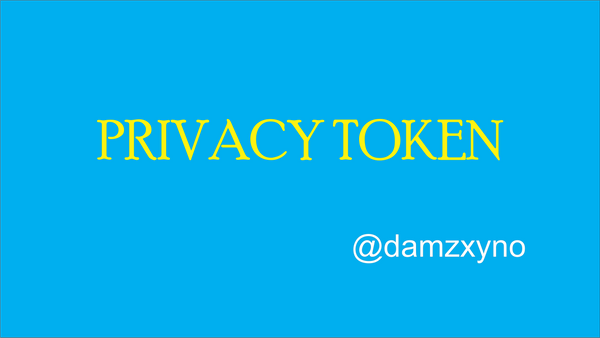
1. Choose a Privacy Coin and perform a fundamental analysis of the coin in detail.
The Privacy token I have chosen to perform a fundamental analysis on is the Grin coin. It was launched in January 2019 utilizing the Mimblewimble protocol to conceal and create anonymity in the blockchain. The project all started when an anonymous individual with a pseudonym which goes by the name Tom Elvis Jedusor created a document with the title Mimblewimble in July 2016 which was hosted on Tor hidden service[Jed16]. He left a link to this document in the bitcoin research IRC channel and immediately signed out of the channel. This document got the attention and interest of many developers, one of which was Andrew Poelstra.
Andrew Poelstra is a director of research at Blockstream, a blockchain technology company in Canada which is a name to be recorned with among providers open-source and commercial Bitcoin technologies. This company was co-founded by Adams Back, the creator of HashCash and 8 others in 2014 to advance the development of bitcoin core. Andrew Poelstra is a software engineer and mathematician with numerous published papers on topics involving cryptography, privacy and bitcoin. He took interest in the document dropped by Jedusor that he published a paper which was an improvement on the the first whitepaper released by Jedusor. In Jedusor's paper, he failed to discuss about security. Poelstra's whitepaper communicated the original idea of Jedusor and added scaling improvements
Unlike bitcoin which uses over 100Gb of data to record a single transaction, Mimblewimble protocol helps reduce this to less than a megabyte. This help tackle the scaling issue associated with bitcoin. Mimblewimble also help create anonymity among other benefits successfully that different forks of bitcoin have not been able to achieve. Furthermore, in October 2016, another developer, anonymous and with the pseudonym Ignotus Peverell began to work on implementing the Mimblewimble protocol. Several other developers joined the team and the Grin project was initiated. Grin was finally launched on 15th of January, 2019. Today not only Grin uses the mimble wimble protocol, Beam as well uses it.
The mimblewimble method works using binding factors- these are random values chosen by a user who intends sending coins. The receiver of the coins has to choose from these random values, if the receiver picks similar values, the transaction is validified. This methods functions as a proof of ownership verifying and authorizing the new possessor of the coins.
Grin is among the top privacy coins and it uniqueness is based on its mimblewimble protocol as well as anonymity and independence of the project of its founder. Hence, because of the anonymity of it founder, developers of this coin are paid through donations. As at the time of this writing, the circulating supply of this coin is 74,760360 with a market cap of $29,463,573. Grin is traded on different top exchanges such as XT.com, BitFOrex, HitBTC, KuCoin and Gate.io. For example, on Gate.io, Grin/USDT pair has an average 24 hours trading volume of $319,071. This is pretty fair. On CoinMarketCap, it is ranked #663 with over 15,657 watchlists. This is a good project we can venture into for future investments as it holds promises. The current value of this coin is $0.394.
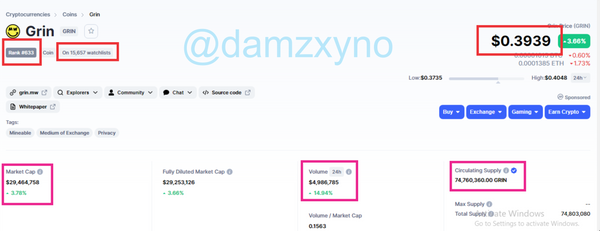
2. Describe the steps in creating a wallet for the Privacy Coin of your choice. (Screenshot required)
The official Grin Wallet doesn't have a graphic user interface. It is all console. However, there are many community projects such as Nifller, Grin++ and Ironbelly to solve this problem. I decided to download the Grin++ for my Pc. Grin++ is designed in the C++ programing language, it is fast, secure and reliable, and most importantly, it has a friendly user interface.
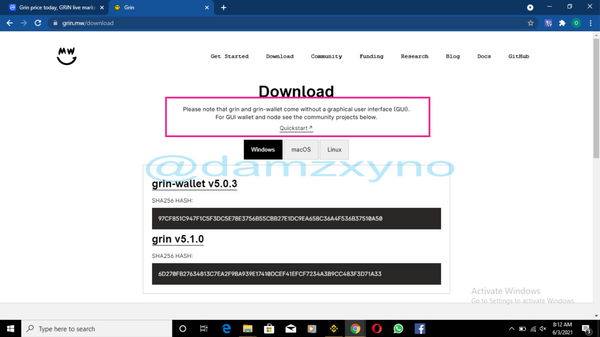
The following are the steps I took to download Grin++ on my Pc:
- I visited the Grin++ download url: https://grinplusplus.github.io/. Here, I clicked on the download button and the application .exe file started downloading. The file size is 91mb.
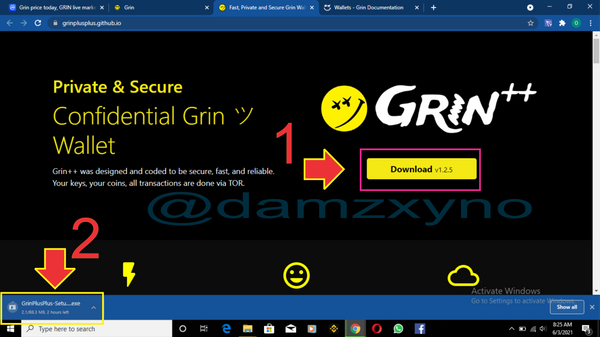
- After downloading, I clicked on the executable file to install the Grin++ software. Then I clicked on the create wallet button. This is because I am creating a new wallet. If I had a wallet already, all I needed was to click on restore wallet.
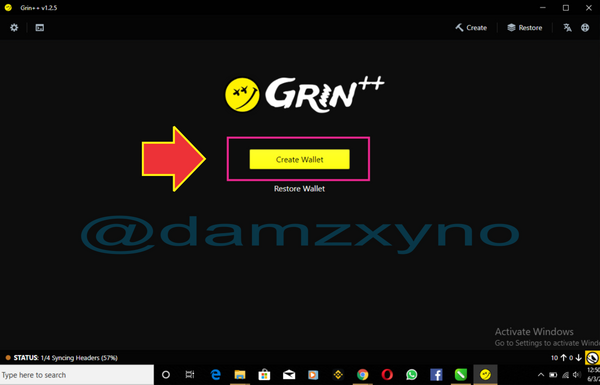
- A new window opened for me to create a new wallet. I inputted my unique username and password. I chose a 24 seed phrase to increase my account security.

- A new window opened for me to back up my 24 seed phrase. I have blurred it in the screenshot for security reasons. I wrote the seed phrase down and clicked on continue.
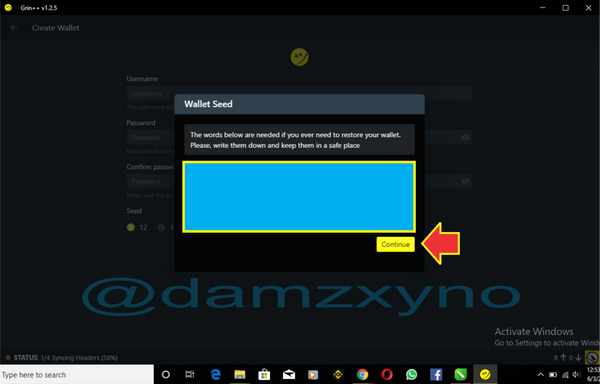
- Now my Grin++ wallet is fully set and ready for transactions. I have blurred out things I believe are private.
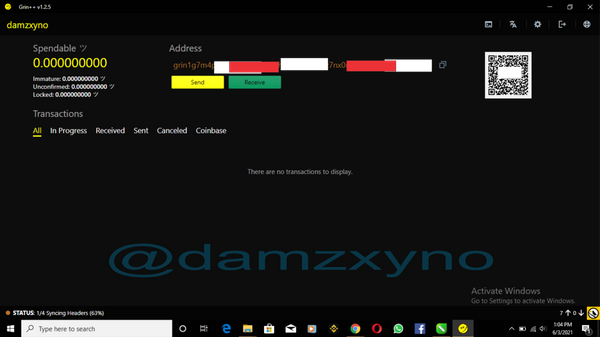
3. Explain the reason you chose the Privacy Coin. (State the advantages and disadvantages)
I chose Grin as my private coin because of its improvement on Bitcoin and other cryptocurrencies. The advantages of Grin is enormous, though it must not be denied that it also posses some very concerning disadvantages. Below are the advantages and disadvantages of Grin.Advantages of Grin
- Anonymity Bitcoin and many other non-privacy token has helped to solve the issue of anonymity but not to its fullest. Public addresses of users can still be traced especially when they are linked to real world persons. However, the technology behind Grin prevents the tracking of transaction histories. In the Grin blockchain, addresses are not made public.
- Fungibility:Fungibility is said to only exist among NFTs which happen to files and not currencies. However, in the Grin network, currencies can be fungible, this means the value is not the same. Grin coins can be tainted especially when they are associated with illegal activities. These coins begin to loose value if accepted by other people. This is one of the ways the coin help to prevent the use to foster terrorism and fraud.
- Scalability: The blocksize of Grin is relatively very smaller than the Bitcoin block. This is a massive improvement when data is brought to view. About 15 gigabyte of data is required to record a single transaction, this is with the exception of UTXO set and range proofs which when included will take over 100 gigabyte of data. However, to record a single transaction, only 1.5 Mb.
- Mining rewards: Although this is controversial, I'll include it among the advantages because the network is not creating opportunity for miners based on the time they began mining. All miners receive the same reward irrespective of the time they joined the network.
Disadvantages of Grin
- Competition: Grin as a privacy coin has big competitions such as Monero and Dash coins. These coins are more popular and this posses a disadvantage to the coin
- Reliance on Digital signatories: This is a problem as reliance on digital signatories creates vulnerability to attacks, especially ones conducted by quantum computers.
- Fraudulent use: This is a general problems of all privacy coins. They can be used to sponsor very dangerous and illegal activities. The problem exist in the fact that these transactions can not be tranced.
This is a link to my twitter post:
https://twitter.com/Damzxyno/status/1400448687445139463?s=20
Hi @damzxyno, Thank you for taking my class in the 8th week.
This is the detailed assessment that you get from the results of writing the homework that you have created:
Review dan Feedback:
Your fundamental analysis is good, but it could be improved by digging up more information.
Explanation of wallet creation is complete.
You only make the advantages and disadvantages, I want you to explain the reasons for choosing the privacy coin in your own words. While the advantages and disadvantages are only supporting factors for your explanation.
Thank you!